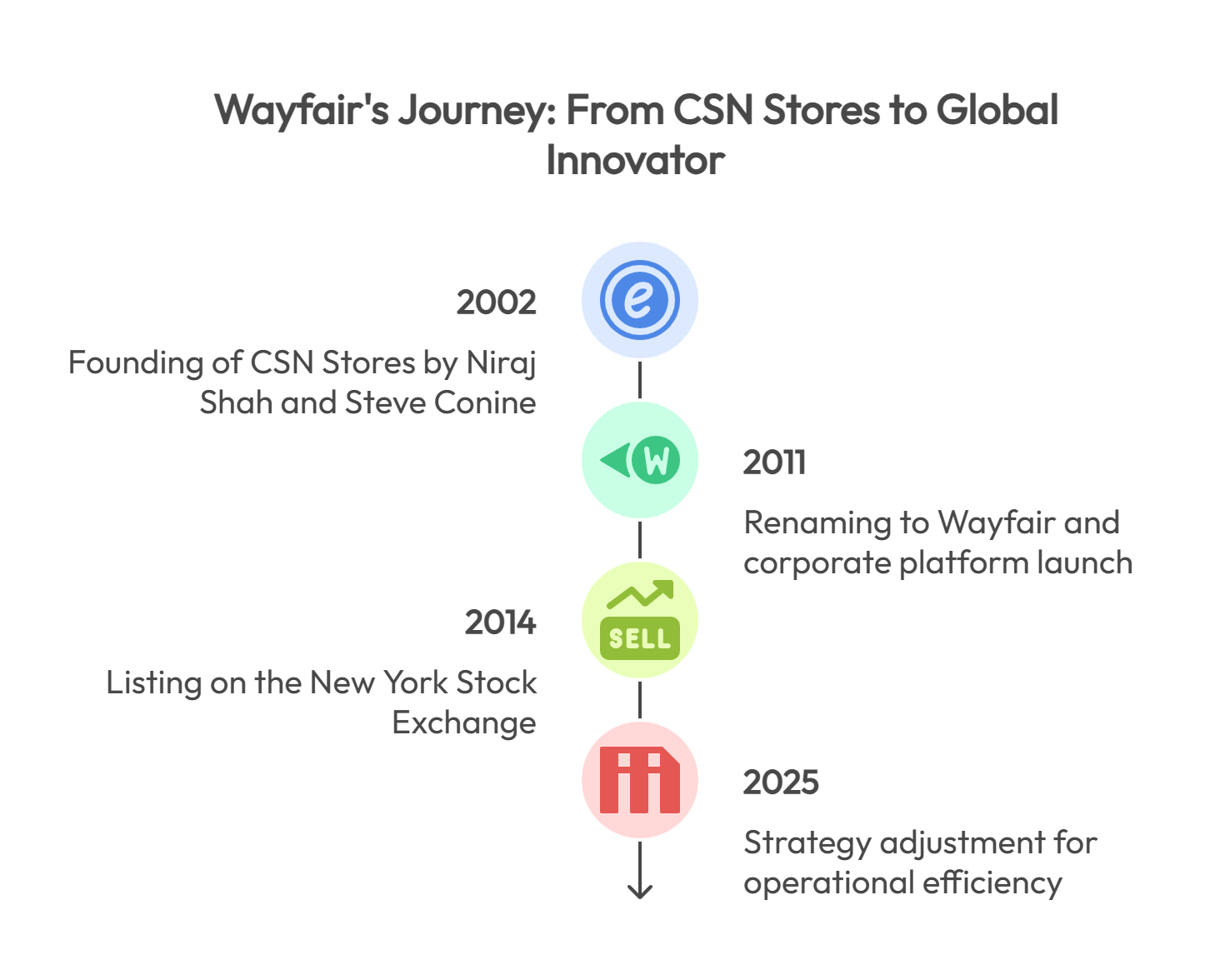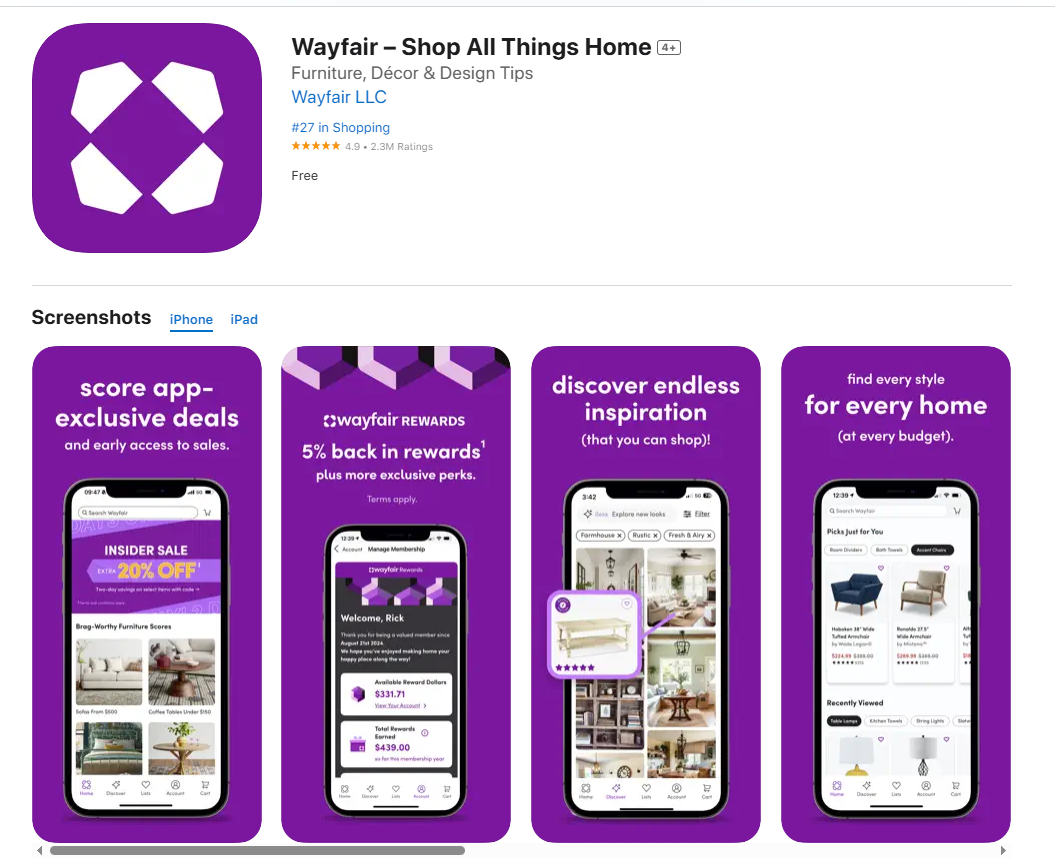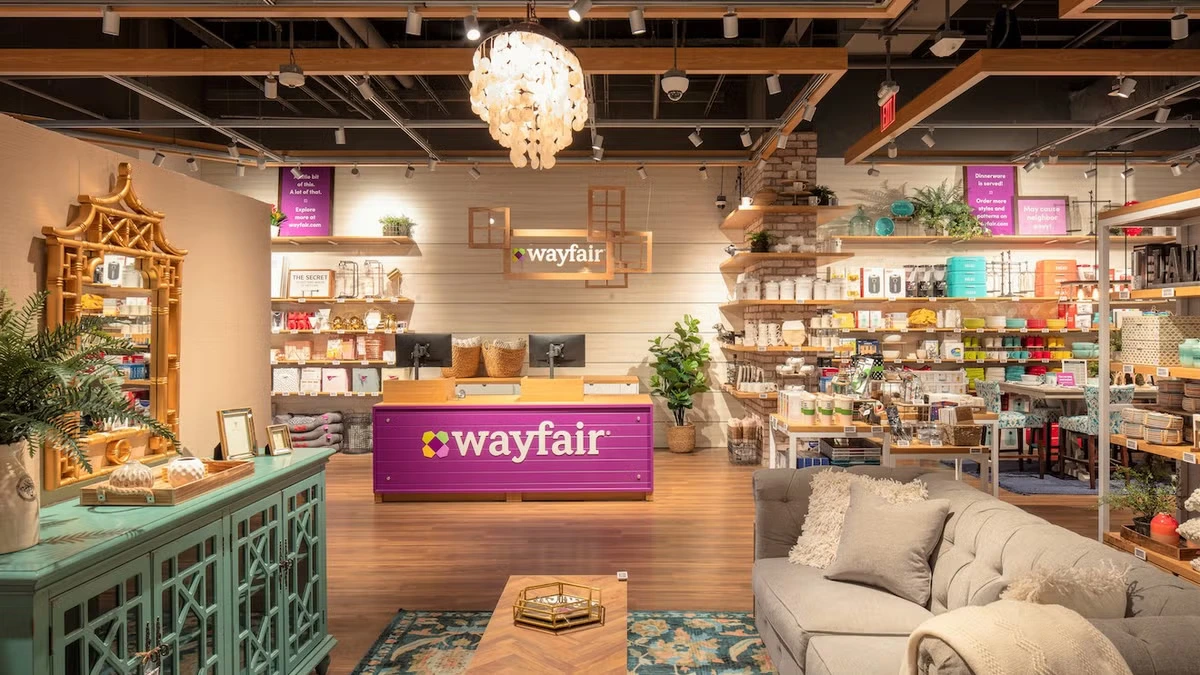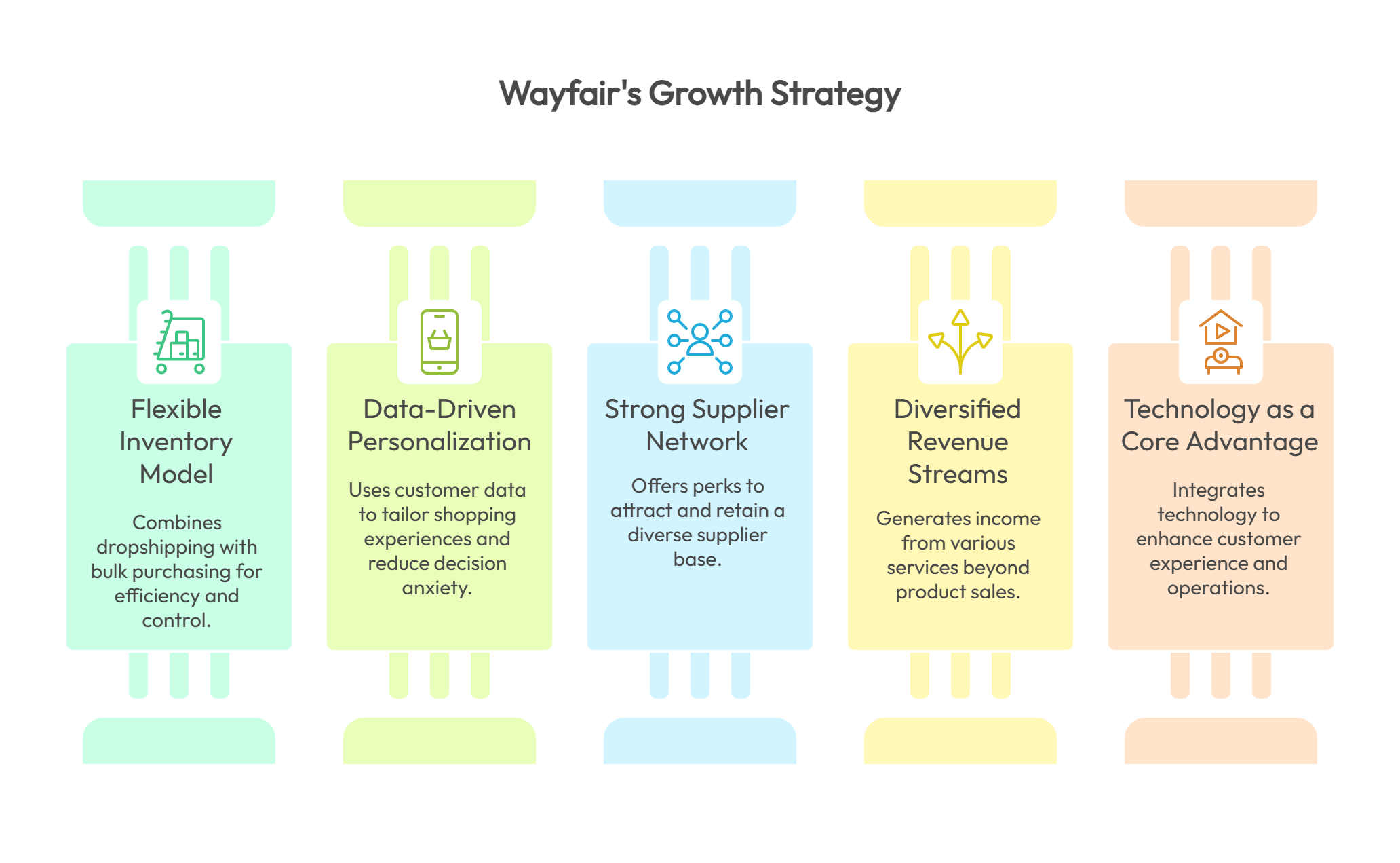Wayfair Business Model: How Does Wayfair Make Money?

Wayfair is one of the biggest names in e-commerce in the US, specializing in selling furniture and homewares online. Starting as a group of niche stores established by two founders Niraj Shah and Steve Conine, Wayfair has grown strongly thanks to a smart expansion strategy and the ability to connect with thousands of global suppliers. The analysis below will help you understand Wayfair business model, how Wayfair operates and makes profits, and draw practical lessons that can be applied to businesses looking to grow in the e-commerce market.
>> You may also like:
What is Wayfair?
Wayfair’s journey from a nascent online venture to an e-commerce powerhouse is characterized by strategic evolution, aggressive expansion, and a keen understanding of the digital retail environment.
Company History and Evolution
Wayfair began in 2002 as CSN Stores, founded by two college friends, Niraj Shah and Steve Conine. From a makeshift home office, they built a chain of small websites that sold each separate line of furniture. This strategy helped Wayfair expand its catalog quickly without a large initial investment.
By 2011, after developing more than 200 websites, the company officially changed its name to Wayfair to unify the brand, improve user experience, and optimize operations. At the same time, Wayfair also launched a platform for corporate customers and acquired DwellStudio to enhance product design capabilities. In 2014, Wayfair listed on the New York Stock Exchange, marking an important milestone in its development journey.
Wayfair is constantly innovating. They gradually expanded internationally, experimenting with physical retail with pop-up stores and then moving to permanent stores, while developing sub-brands such as AllModern, Birch Lane, Joss & Main and Perigold. Combining online and offline experiences helps Wayfair increase trust, improve customer journeys and optimize conversion rates.
Despite a period of strong growth in personnel, Wayfair has also adjusted its strategy to focus on operational efficiency, including cutting staff and withdrawing from some markets such as Germany and Austria by 2025.

Product Offerings and Scale
Wayfair boasts an extraordinarily extensive product catalog, comprising 14 million distinct items across a vast array of furniture and home goods. This comprehensive selection spans categories including furniture, rugs, wall decor, kitchen supplies, lighting products, home appliances, textiles, and bathroom fittings, providing a “one-stop shop” for home furnishing needs. The sheer breadth and depth of this offering are made possible through strategic partnerships with over 11,000 global suppliers and collaborations with hundreds of renowned brands such as Three Posts, Bosch, Kohler, and Samsung, ensuring both variety and quality.
Key Brands and Market Presence
Beyond its flagship Wayfair.com, the company strategically operates five distinct specialty retail brands, each designed to cater to specific market segments and aesthetic preferences :
- AllModern: Focused on contemporary, minimalist, and mid-century modern furniture, with a growing presence of physical brick-and-mortar stores.
- Birch Lane: Offers traditional and classic styles, also expanding its reach through physical retail locations.
- Joss & Main: Originally conceived as a membership-exclusive online retailer for flash sales on home furnishings and decor, it has evolved to include both online and physical store operations.
- Perigold: Positioned as Wayfair’s luxury home retail brand, Perigold features high-end designer brands, complemented by free design services and shipping advantages to its discerning clientele.
The Wayfair Business Model Canvas: A Strategic Deep Dive
This section analyzes Wayfair’s operations through the comprehensive lens of the Business Model Canvas, providing a structured understanding of its core components and their interplay.

Customer Segments
As a quintessential multi-sided platform, Wayfair primarily serves two distinct and interdependent client groups :
- Purchasers seeking household items: This broad and diverse segment encompasses individuals and families across various demographics and income levels, from first-time homeowners to seasoned decorators.
- Providers of household goods: This group includes the thousands of brands, manufacturers, and suppliers who leverage Wayfair’s platform to reach a vast customer base.
Wayfair segments its market intelligently. Demographically, the company focuses on consumers who want to improve their living space, especially those in the middle class who love variety and good value. With a strong online sales channel, Wayfair serves customers across the US and some international markets such as the UK, Germany, Ireland and Canada.
Behaviorally, Wayfair caters to both casual shoppers and those who regularly renovate their homes. Its core customer base is tech-savvy, who enjoy the convenience of online shopping and want a wide range of options at reasonable prices.
Value Propositions
Wayfair business model offers unique value to both its customer segments.
For Purchasers/Customers
Wayfair’s value proposition for customers revolves around unparalleled choice, convenience, and a personalized shopping experience:
- Vast Variety and Selection: The platform offers an immense catalog of 14 million items, encompassing a wide range of designs, styles, and price points from over 11,000 global suppliers. This “endless aisle” approach ensures customers can find precisely what they need.
- Convenience and Personalization: Wayfair enables customers to efficiently locate the ideal item at the ideal cost through a user-friendly website and app. The platform provides a highly customized experience, dynamically adapting based on individual browsing and purchasing trends and habits.
- Enhanced Shopping Experience: The company utilizes innovative tools such as the “Room Planner” and Augmented Reality (AR) features within its app, allowing customers to visualize furniture and décor realistically within their own homes before making a purchase. This significantly enhances satisfaction and reduces purchase uncertainty.
- Value-Added Content: Beyond transactional sales, Wayfair provides valuable content through its blog and the “Wayfair Ideas & Advice” section, offering home decorating tips, design inspiration, and DIY advice. This positions Wayfair as a trusted resource, building rapport and drawing potential customers even before a purchase decision.
For Suppliers/Providers
Wayfair offers compelling value propositions designed to attract and retain its vast network of suppliers:
- Access to Broad Customer Base: The platform provides suppliers with unparalleled access to a massive and diverse customer base, exceeding 33 million customers, enabling them to showcase their entire product range to a wide audience they might not otherwise reach.
- Significant Cost Savings: Wayfair empowers suppliers to ship products directly to customers, which substantially reduces their costs associated with warehousing, inventory management, and developing and promoting their own sales channels. Crucially, Wayfair absorbs the entire shipping cost for drop-shipped orders and does not impose any fees on these transactions, a distinct advantage over competitors like Amazon.
- Marketing and Exposure: The platform offers robust opportunities for suppliers to purchase sponsored placements, providing increased product visibility and exposure within search results, category pages, and through native advertising and sponsored content.
Channels
Wayfair utilizes a multi-channel approach to reach and deliver value to its customer segments.
Online Platforms
- Wayfair.com: The flagship e-commerce website serves as the primary digital storefront. It is meticulously designed for a user-friendly browsing and purchasing experience, dynamically adjusting content and recommendations based on customer data.
- Specialty Retail Brands’ Websites: Wayfair operates dedicated online presences for its distinct brands—AllModern, Birch Lane, Joss & Main, and Perigold—each offering a curated selection tailored to specific aesthetic preferences.
- Mobile App: A critical channel that enhances the shopping experience with innovative features like Augmented Reality (AR) for product visualization, enabling a more immersive and personalized interaction.

Tips: If you’re running a Shopify store and wondering how to elevate the customer experience like Wayfair did, a mobile app might be your next big move. With SimiCart mobile app builder, you can easily build a fully branded, feature-rich shopping app with no coding needed. Try SimiCart today and see how a mobile app can boost your sales, strengthen customer loyalty, and bring your online store closer to your audience than ever before.
Marketing Channels
Wayfair employs a comprehensive digital marketing strategy:
- Search Engine Optimization (SEO) & Content Marketing: Significant investments are made in SEO and content marketing to ensure high visibility in search engine results. This includes a robust blog and “Wayfair Ideas & Advice” sections that provide helpful, engaging content, drawing organic traffic.
- Targeted Digital Advertising: Wayfair excels in precision advertising across various digital channels, leveraging customer data to identify and target individuals most likely to be interested in specific products, leading to higher conversion rates.
- Social Media Engagement: The company actively engages with customers through social media platforms, exemplified by successful Facebook ad campaigns utilizing dynamic retargeting to re-engage users who have viewed products but not purchased.
- Influencer Marketing: Wayfair collaborates with micro-influencers, nano-influencers, and niche influencers who resonate with home decor enthusiasts. For example, the company has worked with personalities from TV shows like The Bachelorette (e.g., Sean and Catherine Lowe) to target female audiences, leveraging their authentic appeal to drive engagement.

Wayfair blog “Wayfair Ideas & Advice”
Physical Channels (Emerging)
Brick-and-Mortar Stores: In a strategic move, Wayfair and its specialty brands have begun opening physical stores. This omnichannel approach aims to enhance brand presence, provide tactile experiences for high-consideration purchases, and cater to diverse customer shopping preferences.

Customer Relationships
Wayfair’s approach to customer relationships is deeply integrated into its marketing strategy, focusing on satisfaction and loyalty.
- Personalized Shopping Experience: At its core, Wayfair’s approach is built on leveraging data-driven personalization. By analyzing browsing history, purchase data, and utilizing tools like the “Room Planner,” Wayfair anticipates and meets individual customer needs, fostering increased engagement and repeat purchases.
- Customer Support: The company provides comprehensive 24/7 client support, ensuring that customer inquiries, issues, and post-purchase needs are addressed promptly and effectively, contributing significantly to overall customer satisfaction.
- User-Friendly Platform: Wayfair positions itself as a convenient, one-stop online destination for home goods, emphasizing ease of navigation, intuitive design, and a seamless shopping experience to appeal to a broad customer base.
- Value Beyond Sales: Wayfair fosters deeper relationships by offering valuable, non-transactional content through its blog and “Ideas & Advice” section. This approach provides home design tips and inspiration, building rapport and offering value to customers even before a purchase is made.
- Efficient Logistics: A strong focus on optimizing logistics for fast and reliable delivery across its operational regions is crucial. This commitment to a seamless customer experience, from initial product discovery to final delivery, significantly contributes to satisfaction and loyalty.
- Financial Incentives: The introduction of co-branded credit cards with benefits such as initial purchase discounts and cashback rewards serves to deepen customer loyalty, incentivize repeat purchases, and enhance the overall customer lifetime value.
Revenue Streams
Wayfair generates revenue through a diverse and multi-faceted set of channels, strategically moving beyond simple product sales. These include product sales, installation services, platform advertising, interchange fees, and interest charges. These will be elaborated upon in a dedicated section below.
Key Resources
Wayfair’s most crucial resources include its technological platform, its extensive network of 11,000 suppliers, and its 16,000 employees.
- Technological Platform and Algorithms: This encompasses its sophisticated, user-friendly website, mobile app, proprietary algorithms, and advanced tracking systems for customer patterns and behavior. This technological backbone is paramount for personalization, operational efficiency, and maintaining a competitive edge.
- Extensive Supplier Network: A critical asset comprising over 11,000 global suppliers, which collectively provide the immense catalog of 14 million items. The robust agreements and contracts with these suppliers are fundamental to Wayfair’s ability to offer unparalleled product variety.
- Human Capital: A substantial workforce of over 16,000 employees (including approximately 2,300 engineers and data scientists, and 3,000 customer service representatives) across various global locations. These skilled professionals drive innovation, manage operations, and ensure customer satisfaction.
- Lifestyle Brands: Its strategically developed portfolio of five owned and operated brands (Wayfair, AllModern, Birch Lane, Joss & Main, Perigold), which effectively segment the market and cater to diverse customer tastes and preferences.
- Logistical Infrastructure: Despite its significant reliance on dropshipping, Wayfair possesses substantial logistical resources, including automated payment and logistical procedures, and over 12 million square feet of warehouse space across Europe and North America, supported by a dozen fulfillment centers.
- Customer Data: The vast amount of first-party data collected on customer browsing history, purchasing habits, and preferences is a highly valuable asset. This data fuels Wayfair’s personalization engine, informs targeted marketing campaigns, and drives continuous platform improvement.
Key Activities
Wayfair’s core initiatives are focused on expanding its product collection and maintaining its multi-faceted platform to connect customers and suppliers effectively.
- Platform Development and Maintenance: Continuously creating, sustaining, and enhancing its multifaceted e-commerce platform, which involves ongoing improvement and updating of its proprietary algorithms to ensure optimal performance and user experience.
- Product Curation and Management: A core activity involving the continuous expansion of its furniture and home products collection, ensuring high-quality product listings by publishing items created by professionals, and diligently keeping the extensive catalog up to date and accurately managed.
- Data Analysis and Personalization: A critical, data-driven activity focused on analyzing consumer shopping patterns and behavior. This analysis is used to tailor product offerings, refine recommendations, and improve the overall customer experience, driving Wayfair’s highly personalized approach.
- Supplier Relationship Management: Actively managing relationships and agreements with its thousands of suppliers, which includes onboarding new partners, negotiating terms, and ensuring a robust, diverse, and reliable product supply chain.
- Marketing and Promotion: Investing heavily in promotion and marketing efforts, encompassing a wide range of activities such as SEO, content marketing, highly targeted digital advertising, social media engagement, and influencer marketing to attract and retain customers.
- Logistics and Delivery Management: Ensuring agile and efficient delivery of products, which involves managing automated payment and logistical procedures. This is crucial for customer satisfaction, even when products are drop-shipped directly from suppliers.
- Customer Support: Providing comprehensive and accessible client support (24/7) to address customer inquiries, resolve issues, and ensure a positive post-purchase experience, which is vital for building trust and loyalty.
Key Partnerships
Wayfair’s operational model relies heavily on a network of critical collaborations.
- Global Suppliers: The most fundamental partners, numbering over 11,000, who are indispensable for providing Wayfair’s extensive product catalog. The strength of Wayfair’s agreements and contracts with these suppliers forms the bedrock of its value proposition.
- Logistics Providers: Wayfair’s operational model, particularly its commitment to efficient and agile delivery and its hybrid inventory model, necessitates strong partnerships with various shipping and fulfillment companies, especially given the significant drop-shipping component.
- Service Providers (e.g., Handy): Strategic partnerships with companies like Handy for ancillary services such as furniture assembly. These collaborations add significant value for customers by offering convenience and simultaneously create an additional revenue stream for Wayfair.
- Financial Institutions (Mastercard, CitiBank): Key partnerships with major financial entities like Mastercard and CitiBank for the issuance of co-branded credit cards. These collaborations enable Wayfair to offer financial services to its customers, generating revenue through interchange fees and interest charges.
- Technology Partners: Implicitly, Wayfair relies on various technology partners for the development, maintenance, and enhancement of its advanced platform, sophisticated algorithms, and innovative features such as Augmented Reality.
Cost Structure
Wayfair’s automated and hybrid drop-shipping business strategy is fundamentally designed to minimize and streamline its cost structure by reducing the need for extensive physical inventory holdings.
Largest Cost Drivers:
- Labor Costs: Represent a significant expenditure due to Wayfair’s large global employee base, which includes a substantial number of highly skilled engineers, data scientists, and a large customer service team.
- Promotion and Marketing Costs: Wayfair invests heavily in customer acquisition and brand building, with marketing and advertising being among its largest cost drivers. For instance, the company expected to spend over $1 billion on marketing in 2019. This encompasses a wide array of activities including targeted advertising, SEO, content marketing, and influencer campaigns.
Other Significant Costs:
- Operational Expenses: Pertain to the day-to-day running of its extensive online platform and managing its complex supply chain, including costs associated with its warehouse space and fulfillment centers.
- Technological Expenses: Involve substantial investments in developing, improving, and maintaining its proprietary algorithms, tracking systems, and other technological innovations like AR, which are crucial for its competitive differentiation.
- Administrative and General Expenses: Cover the overhead costs associated with managing the overall business operations.
- Legal Expenses: Include costs related to navigating complex legal challenges, such as the landmark sales tax lawsuit.
- Research and Development (R&D): Ongoing investment in innovation and the development of new features and services to maintain market leadership.
- Shipping Costs: A notable and differentiating operational expense is Wayfair’s policy of covering the entire shipping cost for its drop-shipped orders. This strategic decision, while a significant cost, enhances supplier appeal and contributes to customer satisfaction.
How Wayfair Makes Money: A Detailed Financial Perspective
Wayfair’s revenue generation strategy is sophisticated and multi-faceted, extending significantly beyond traditional product sales to strategically leverage its expansive platform, vast customer base, and integrated financial services.
Product Sales
The majority of Wayfair’s revenue comes from sales on its platform. Initially based on the dropshipping model, Wayfair later switched to a combination of self-importing in large quantities and dropshipping to be more proactive in terms of price, inventory and delivery quality. Notably, Wayfair does not charge suppliers and covers all shipping costs for dropship orders. This policy helps retain partners and enrich the product catalog on the platform.
Installation Services
To make things easier for customers, Wayfair has partnered with Handy to offer in-home furniture assembly services. Customers can opt in to this service at checkout. While Handy takes the lion’s share of the fee, Wayfair still receives a commission from each referral, adding a significant amount of revenue to the platform.
Platform Advertising
Similar to major e-commerce platforms, Wayfair allows brands to pay for prominent display space on its website. This form of advertising can be priority placement in search results, sponsored posts, or promotions on channels like Wayfair’s YouTube. This is an attractive revenue stream as the platform has more than 33 million users, making it easier for brands to reach their target customers.
Interchange Fees
Wayfair has launched two credit cards with Mastercard and CitiBank. Users get cash back, discounts, and installment offers on purchases, while Wayfair gets a portion of the interchange fee for each swipe. In addition, when customers default on payments, Wayfair benefits from high interest rates on outstanding balances.
Interest Charges
For installment purchases that are not paid on time, customers will be charged interest rates of up to 26.99%. This is a steady and significant income stream, especially when associated with large value transactions such as high-end furniture.
Why does Wayfair business model work?
Instead of relying solely on sales profits (which are vulnerable to high shipping costs and price competition), Wayfair spreads its risk by diversifying its revenue streams. Advertising revenue can help offset customer acquisition costs, while credit card revenue increases customer lifetime value (LTV).
Furthermore, financial solutions such as credit cards and installment payments not only increase sales but also create long-term customer loyalty. Wayfair can collect spending behavior data, thereby optimizing personalization and remarketing more effectively. All of these factors create a comprehensive commerce ecosystem, retain users, and create a clear competitive advantage in the market.
Learning from Wayfair business model: Actionable Insights for Your Business
Wayfair’s impressive growth journey offers a practical playbook for eCommerce businesses, especially those selling bulky or high-value products like home furnishings.

1. Flexible Inventory Model
Wayfair evolved from a pure dropshipping model to a hybrid one that combines dropshipping with bulk purchasing. This allows them to offer a vast product catalog while gaining better control over pricing, quality, and shipping speed.
👉 Businesses can adopt a similar strategy: use dropshipping for niche or slower-moving items to minimize storage costs, while stocking high-demand products to boost profit margins and fulfillment speed.
2. Data-Driven Personalization
Wayfair makes powerful use of customer data to personalize the shopping experience, from smart product recommendations to tools like the “Room Planner” and AR that help customers visualize items in their space.
👉 Businesses should invest in data analytics to understand user behavior and tailor the customer journey. Integrating tech that reduces decision anxiety—especially for large or visually-driven purchases—can drive higher conversions.
3. Building a Strong Supplier Network
With over 11,000 suppliers worldwide, Wayfair offers perks like free dropshipping and subsidized shipping costs, making the platform highly attractive for sellers. This fuels product variety and competitiveness.
👉 If you run a platform model, focus on delivering real value to your suppliers—such as low fees, marketing support, and access to a broad customer base—to build a loyal and diverse supplier network.
4. Diversifying Revenue Streams
Beyond product sales, Wayfair generates revenue from services like installation, ad placements, and financial offerings (e.g., credit cards and financing). This approach strengthens cash flow and increases customer lifetime value.
👉 Consider offering complementary services—installation, maintenance, extended warranties, or payment plans. You can also monetize your platform by allowing partners or suppliers to advertise their products.
5. Technology as a Core Advantage
Wayfair treats technology not just as a tool, but a strategic asset. From AI-powered personalization to AR tools, their tech stack is deeply integrated into the customer experience and operations.
👉 Businesses should view tech as a long-term strategic differentiator—essential not just for efficiency, but for creating a seamless, standout shopping experience that builds trust and reduces friction.
>> Explore: AR in eCommerce: Use cases and best examples
Conclusion
Wayfair business model showcases how strategic agility, data-driven personalization, and supplier-centric operations can fuel success in complex eCommerce categories. By blending a hybrid inventory model with advanced technology and a strong supplier network, the company creates both scale and efficiency. Its diversified revenue approach enhances financial stability while maximizing customer value. Despite market challenges, Wayfair remains a blueprint for building resilient and adaptive online retail businesses. The lessons here are clear: prioritize flexibility, leverage data, support your ecosystem, and never rely on product sales alone.

